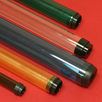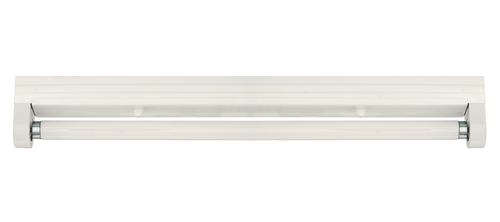Whether your cleaning a fixture, replacing a bulb, replacing or cleaning a lens cover, this routine maintenance can be dangerous if fluorescent bulbs are not handled with care. Avoid leaving a fluorescent bulb exposed (without lens cover) like this:
Exposed bulbs increase the chances of breaking. You should be extremely careful especially around kids. If you have kids, or work with kids you know that there no such thing as being too cautious! The worst-case scenario would be that your exposed fluorescent light bulb is struck with a ball or toy, shattering in a million pieces with kids in the room.
Why Are Fluorescents Dangerous When Broken?
All fluorescent bulbs contain a small amount of mercury. When they break, that small amount will be released in the form of toxic mercury vapor. When this does happen, it’s best that pregnant women and youth are not present as exposure can affect the developing brain and central nervous system. It’s best to keep fluorescents away from area’s where children play or places where bulbs may be more prone to break.
If one does break accidentally, it’s okay! Just follow a few steps to help reduce negative health outcomes:
- Clear out the room; no infants, children or animals.
- Do not clean up the bulb if you are pregnant.
- Turn off fans and central air conditioners.
- Open windows to let in fresh air.
- Leave the room for at least 15 minutes to allow the room to air out.
Solution
 If you want to avoid all of the hassle, the mess and the health risks of broken fluorescent bulbs your solution is to purchase tube guards. They are easy to install sliding right over the fluorescent tube, so in case the tube breaks, shards of glass and mercury vapor wont go all over the place! Check out our selection of tube guards if you’ve got unprotected bulbs. We’ve got a large selection of clear and colored tubes- just in case you want to give your space a new look and feel!
If you want to avoid all of the hassle, the mess and the health risks of broken fluorescent bulbs your solution is to purchase tube guards. They are easy to install sliding right over the fluorescent tube, so in case the tube breaks, shards of glass and mercury vapor wont go all over the place! Check out our selection of tube guards if you’ve got unprotected bulbs. We’ve got a large selection of clear and colored tubes- just in case you want to give your space a new look and feel!
Where to Recycle Broken Bulbs
- Check the hardware store. Many of them will recycle fluorescent bulbs for you.
- Check with the local Department of Public Works in your area to find some options for recycling spent CFL bulbs.
References:
Full PDF from the Connecticut Department of Public Health here:
http://www.ct.gov/dph/lib/dph/environmental_health/eoha/pdf/cfl_fact_sheet.pdf



